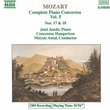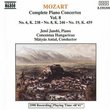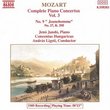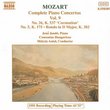| All Artists: Wolfgang Amadeus Mozart, Matyas Antal, Concentus Hungaricus, Jenö Jandó Title: Mozart: Piano Concertos Nos. 23 & 24 Members Wishing: 0 Total Copies: 0 Label: Naxos Original Release Date: 1/1/1991 Re-Release Date: 2/15/1994 Genre: Classical Styles: Forms & Genres, Concertos, Historical Periods, Classical (c.1770-1830), Instruments, Keyboard Number of Discs: 1 SwapaCD Credits: 1 UPC: 730099520423 |
Search - Wolfgang Amadeus Mozart, Matyas Antal, Concentus Hungaricus :: Mozart: Piano Concertos Nos. 23 & 24
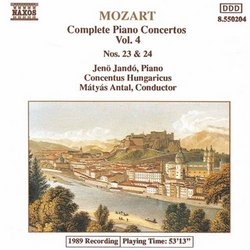 | Wolfgang Amadeus Mozart, Matyas Antal, Concentus Hungaricus Mozart: Piano Concertos Nos. 23 & 24 Genre: Classical
|
Larger Image |
CD DetailsSimilar CDs |
CD ReviewsExploring the Mozart Piano Concertos -- K. 488 and K. 491 Robin Friedman | Washington, D.C. United States | 06/16/2004 (4 out of 5 stars) "Between 1784 and 1786, Mozart wrote 12 piano concertos, most of which he performed during subscription concerts he organized in Vienna. These concertos are among the greatest of his compositions. In them, Mozart achieved works of great variety with full, symphonic orchestral writing, and brilliant passages for the solo piano. The works effect both a diversity and a unity between the orchestra and the soloist that have never been excelled in writings in this form.Among the greatest of Mozart's piano concertos are the concerto No. 23 in A Major, K. 488 and the Conerto No. 24 in c minor K. 491. These works were written within weeks of each other in March, 1786 and performed with Mozart at the keyboard during the Lenten season. They are performed on the CD under review here by the Concentus Hungaricus under the direction of Matyas Antal with Jeno Jando at the piano. This CD is part of a complete cycle of the 27 Mozart piano concertos on the budget-priced Naxos label. Even though these concertos were written within the space of three weeks, they differ greatly from each other. The concerto in A major, is a lightly-scored work for strings, flute, clarinet, horns, and bassoons with a transparent texture and a lyrical, somewhat melancholy tone. The openings allegro opens with a singing theme in the strings and winds, followed by a more reflective secondary theme. The piano part essentially follows upon and embroiders the opening orchestral exposition with duets between the soloist and various woodwinds. The second movement, an adagio, is the heart of this concerto with a sad, plaintive theme stated in the treble of the piano over repeated chords, followed by orchestral development and, again, passages for winds and piano. The finale, allegro assai, is a forceful quick-moving rondo which in its gaiety and energy dispells the melancholy tone of the opening two movements. This composition is a lucid work, deceptive in its simplicity, and one of the best-known of the Mozart concertos.The c minor concerto, K. 491 is tragic, elegaic and somber in character. Beethoven used it as a model in his third piano concerto in c minor, Opus. 37, producing a work of a substantially different character than Mozart's. The work is written, in contrast to the A major concerto, for a large orchestra with strings, oboe, clarinet, bassoon, horn, trumpet, and tympani. The opening movement is, unusually enough, in 3/4 time and consists of an intense, angry theme with marked rhythm. The piano opens with a quiet, pleading theme, and the movement develops in dark character througout. The slow movement, larghetto, is a rondo in E-flat major. It opens with a singing theme in the piano, with passages alternating between the orchestra and soloist. The movement concludes with an understated, innocent-sounding coda stated by the piano with accompanyment in the bassoon and oboe. The final movement, allegretto, returns to c minor and, unlike some classical minor-key works which shift to the major key at the conclusion, it retains its somber, tragic, c minor character throughout. The work consists of a theme and eight variations which alternate in character and in instrumentation. This is a powerful movement. (It is also a worthwhile exercise for the new listener to follow and pick-out the theme and each variation.)I enjoyed the performances on this CD, and they will serve amply to introduce the new listener to Mozart's piano concertos. There are many recordings available of this music, some of which are outstanding and competitive with this Naxos version in price. The strongest feature of these performance is the clarity of the orchestral sound. Mozart's concertos feature a great deal of writing for the winds (some critics have dubbed them concertos for winds with piano obligato) and clarity of woodwind sound is essential. The wind performances here are lucid and clear and are a standout feature of this recording. The orchestral readings are good. I found the first movement of the A major somewhat rushed in tempo. Pianist Jeno Jando's performance is clear and unforced, a requirement for Mozart, and eloquent. In the c-minor concerto, I thought the performance needed more of a sense of passion, power, and sadness than I found here.Mozart's piano concertos are works every lover of music should get to know. This CD is a fine introduction to two of his best." Pathos and Passion Leslie Richford | Selsingen, Lower Saxony | 12/30/2004 (4 out of 5 stars) "Mozart?s late Piano Concertos are perhaps the highest form that this particular form of music ever reached, and his Nos. 23 and 24 are both exemplary. No. 23 combines an extraordinarily pleasing Allegro first movement (with an original Mozart cadenza) with a moving and melancholy Adagio and a joyful Allegro assai conclusion in which virtuosity for virtuosity?s sake seems to be avoided and the music assumes symphonic proportions. The orchestral colours are determined by the woodwind, where Mozart has replaced the oboes with clarinets; he here does without trumpets and drums.
No. 24 starts with a magnificent theme that was later to inspire Beethoven and which develops throughout the Allegro first movement, crowned here with a cadenza by Johann Nepomuk Hummel (an original one by Mozart not being extant). Professor Arnold Werner-Jensen has correctly described the whole concerto as being full of ?pathos and passion?. Mozart uses a full-blown orchestra for the first time, including both clarinets and oboes, which are given characteristic passages in the Larghetto second movement. The concerto closes with a delightful set of variations and an original Mozart cadenza. For some reason, the Concentus Hungaricus changed its conductor after the first three volumes of their Complete Mozart Piano Concertos edition with Hungarian pianist Jenö Jandó as soloist. The conductor of the first three volumes, Andras Ligeti, harvested great praise for his efforts, in particular for his Concertos Nos. 21 and 9 (Vol. 2 and 3 respectively), and Mátyás Antal, the new conductor, was faced with a considerable task in matching up to Ligeti?s performances. This first attempt (September/October 1989) was not 100% successful, and a careful listening will show why the Penguin Good CD Guide failed to award Vol. 4 with three stars: It is not the playing itself which is at fault (both Jandó and the orchestra being in marvellous form), but the engineers seem not to have been able to capture the airy transparency and spaciousness of the previous two CDs in the series. As with Volume 1, these qualities appear to have been stifled somewhat in order to give the soloist more predominance, which in this instance was not always a wise decision. This is still a very good recording and excellent value for money, but it does not quite match up to the ultra-high standard set by Vols. 2 and 3. " |

 Track Listings (6) - Disc #1
Track Listings (6) - Disc #1